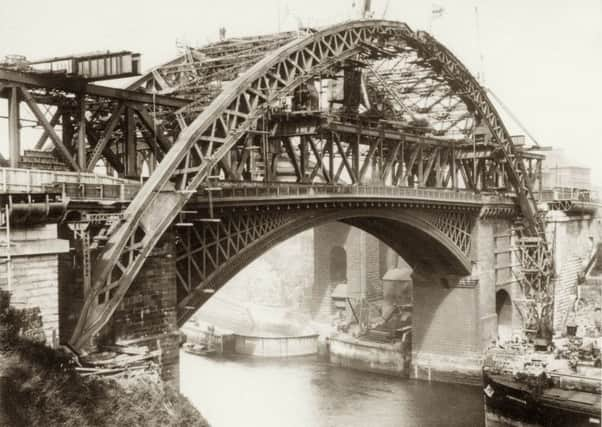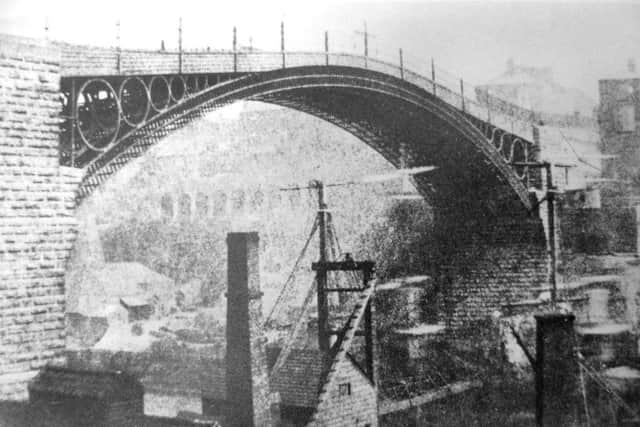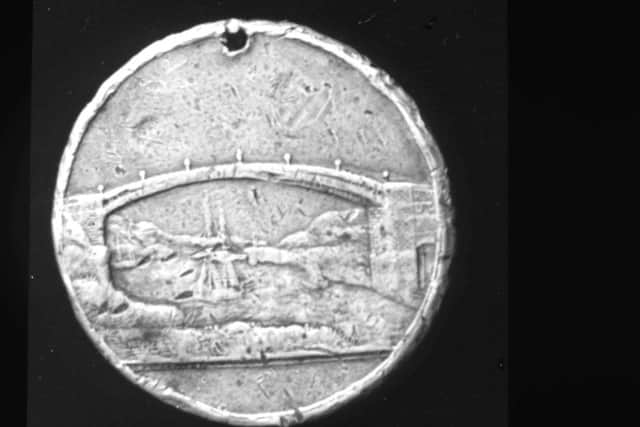Wearmouth Bridge and the part it played in re-shaping Sunderland


The answer is the Wearmouth Bridge, and local historian Beverley Taylor explained more.
With the opening of the Northern Spire just around the corner, what better time to remind ourselves of the history of Sunderland’s very first bridge and the difference it made to Wearside?


Advertisement
Hide AdAdvertisement
Hide AdBeverley, who has recently taken over the role of map archivist at Sunderland Antiquarian Society, looks back.
A truly ingenious piece of engineering – that’s the original Wearmouth Bridge.
And it was very much a record breaker of its time.
It was the longest single-span cast iron bridge in the world, measuring 236ft. Reports vary, but between 214 and 236 tonnes of cast iron were used during the building of it, as well as around 46 tonnes of wrought iron.


The height from the low water mark to the bottom of the bridge was 100ft, and that meant that the newly-built sailing ships could pass freely beneath it on their maiden voyages.
Advertisement
Hide AdAdvertisement
Hide AdWearmouth Bridge was designed by Thomas Paine and built under the direction of Thomas Wilson.
The bridge was born thanks to an Act of Parliament obtained by Rowland Burdon MP in 1792, when it was felt that the townships of Bishopwearmouth and Monkwearmouth would benefit greatly from the building of a bridge.
“Apart from the ferry crossings, the only way to cross the Wear was via New Bridge on the way to Chester-le-Street. A bridge of our own was desperately needed.”
The foundation stone of Wearmouth Bridge was laid on September 24, 1793, and it was officially opened on August 9, 1796.
Advertisement
Hide AdAdvertisement
Hide Ad“As predicted, it made an enormous difference to the town, which simply went from strength to strength,” said Beverley. “A plaque on the bridge today states it ‘proved to be a catalyst for the growth of Sunderland’.
“But a financial problem led to a rather unique event taking place in relation to the bridge.
“Burdon was a partner at a bank in Berwick and had advanced £30,000 on the bridge.
“When the bank failed in 1806, and to avoid any losses, a further Act of Parliament was obtained in order to allow the Bridge Commissioners to sell shares to the public in a lottery.
Advertisement
Hide AdAdvertisement
Hide Ad“The £30,000 was divided into 150 prizes, with the highest prize being £5,000. The draw took place on December 1, 1816, and each of the 6,000 ticket holders was presented with a commemorative medal.
“The prize winners were given a five per cent payment from the bridge tolls, which operated for pedestrians up until 1846 and for vehicles until 1885.”
In 1846, Robert Stephenson, grandson of the famous engineer George Stephenson, reported that the bridge was in sound condition.
However, by 1858 he discovered that there were some serious faults developing, and made recommendations that repairs be carried out which included levelling the hump in the middle and widening the bridge.
Advertisement
Hide AdAdvertisement
Hide AdAlterations began, which cost £40,000, and the new bridge opened on March 5, 1859.
But change was happening fast and the next big arrival was the motor car.
“Increased traffic crossing the bridge caused serious overloading, and in 1924 it was agreed that the bridge needed to be redesigned once again.
“Incredibly, the new bridge was built without having to close it to traffic.
Advertisement
Hide AdAdvertisement
Hide Ad“Once the new structure was in place, the old structure was removed, and the bridge as we know it today finally came into being.
“It cost £220,000 to build, with a further £12,000 was spent dismantling the original bridge.”
Wearmouth Bridge was officially opened on October 31, 1929, by the Duke of York, who would later become King George VI.
As we know, the familiar bridge is still going strong to this day.
Advertisement
Hide AdAdvertisement
Hide AdBeverley added: “As we move into a new era with a brand new crossing over the Wear, it’s easy to forget the story of Sunderland’s original iron bridge.
“But it was the building of Wearmouth Bridge that brought incredible opportunities for the town to develop and grow.
“Perhaps the Northern Spire will bring with it renewed opportunities and signal a brand new era for our fair city.”